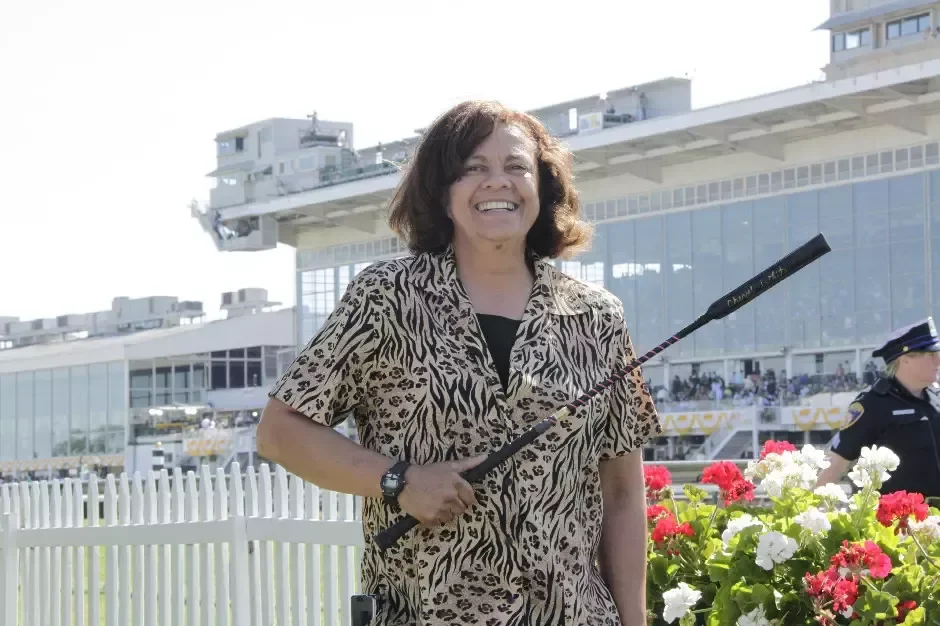
|
Article Audio:
|
The interviewee turned the tables on the interviewer.
“Let me ask you,” Raymond White Jr. said during a phone conversation earlier this month. “When you were doing all your research into Black jockeys, did you ever come across my sister’s name?”
No, I admitted. I had not.
“That’s why we’re doing this,” he responded. “Cheryl White should never not be found when someone is researching Black jockeys.”
Cheryl White was Raymond’s older sister, and “this” refers to the book that he co-wrote with New York Times journalist Sarah Maslin Nir, and to the publicity tour that will bring them to Saratoga Springs on Saturday.
Cheryl was the first licensed Black female jockey, and Nir learned about her from an Instagram account devoted to White’s career. A horsewoman herself who has already written two books about horses, Nir contacted White Jr. to learn more about his sister and to propose a book about her.
“We had talked a lot in the past about writing a book about her,” said Raymond White. “But life gets hectic, and I didn’t really know which way to go to even begin.”
He didn’t expect much from Nir’s call; he not infrequently heard from media people who wanted to learn more about his sister.
“I figured that she’d come interview me and that would be the end of it,” he said. “But it was fate. We all connected, and it just kind of grew from there. Sarah’s family.”
“The Jockey & Her Horse: Inspired by the True Story of the First Black Female Jockey, Cheryl White” will be released on Sept. 5. Published by Cameron Kids, the book features art by Laylie Frazier and is pegged to readers between the ages of 8 and 12. Drawing on Cheryl White’s biography, the book also includes fictional episodes, among them a trip to Senegal.
Raymond White explained why in an author’s note: “That part of the book’s journey … were invented as a way to tell readers the story of enslaved Black equestrians who were purchased to become jockeys, trainers, and grooms. That history, and American thoroughbred racing’s ugly past, is sadly all true.”
Many of the first jockeys in the United States were enslaved or formerly enslaved stable help; 13 of the 15 riders in the first Kentucky Derby were Black, as were 15 of the first 28 winners of the race.
By the early 20th century and the rise of the Jim Crow system and laws, racism pervaded Thoroughbred racing as it did much of U.S. society. Black jockeys were largely driven from the sport, never to regain their prominence. Even now, few Black and African-American jockeys ride in the sport at all, much less as top levels.
Until the late 1960s, gender restrictions kept women out of the saddle during races. In 1968, Kathy Kusner sued the Maryland Racing Commission for the right to ride races, winning the sexual discrimination case. Cheryl White was born in 1953, and she rode her first race at age 17, getting to the winner’s circle for the first time in September 1971.
Hers was a horse racing family: her father was a well-known trainer in the Midwest, running two horses in the Kentucky Derby, one in 1932 and one in the early 1940s. White Jr. started out riding before growing too big; he trained horses before getting out of the business for a career in advertising and marketing, and he’s currently the national director for advertising firm Kabango Media, named after the White family’s best racehorse.
“My father was one of the black trainers who survived the gentrification of the sport,” he said. “Our family has 100 years of history in the sport. My son Raymond III grew up around the racetrack a little bit, and I’m the last one in the family to have that horse racing knowledge, who knows how to train a horse.”
The book about his sister has been optioned for two films, one a feature and one a documentary, and Breyer has created a model that includes Cheryl White astride Jetolara, the horse that she rode to make history as the first licensed Black woman to win a Thoroughbred horse race.
“Representation matters,” said Nir. “We are putting Cheryl on the map where she deserves to be.”
Said White Jr., “This book isn’t meant to inspire Black girls only to become jockeys. We hope it inspires them to become doctors or astronauts or anything they want to put their minds to. We hope that it helps create a place for them in the world.”
Nir and White Jr. will be at the National Racing Museum at 9 a.m. on Saturday, Sept. 2 to unveil the book and sign copies. At 10:30am, they will read from the book, and free copies will be given to attendees under 18 years old while supplies last.
From noon to 1 p.m,, the authors will sign books at the National Museum of Racing and Hall of Fame’s satellite pavilion at Saratoga Race Course. Books will be distributed while supplies last.
There will also be a special named race and trophy presentation in the winner’s circle honoring Cheryl White on the Saturday card.
Categories: At The Track, ATT Newsletter, Horse Racing, Sports




